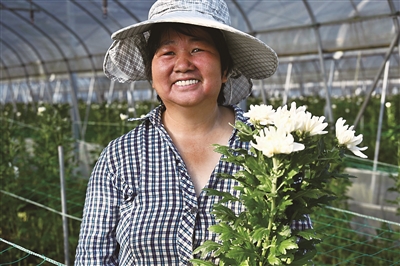
July and August as peak season for the base’s chrysanthemum harvesting (Photo by Xue Caosheng and Chen Siyan (Intern))
In Chenhuang Village, Yunlong Town, Yinzhou District of Ningbo, a 200-mu (ca. 13.3 hectares) flower cultivation base just finished its busiest season of annual harvest for the year of 2022. At the peak of this season, over a hundred farmers worked there every day, and the daily volume of fresh-cut flowers exported to Japan could amount to a truck of containers. These flowers reach the Japanese market within only 7 days. In a one-month period, the Yinzhou base exported 1.7 million chrysanthemums, with sales of 2.5 million yuan.
在鄞州区云龙镇陈黄村,有一片200亩的鲜切花生产种植基地,一年中最忙的采收季刚刚结束。高峰期这里每天有上百人同时采摘,每天有一辆集装箱车运送鲜切花往日本,7天到日本市场。一个月时间,该基地已经出口了170万枝菊花,销售额达到250万元。
Chenhuang Village with ca. 2,500 mu (166.7 hectares) of growing fields had previously specialized in rice cultivation. “We have been considering how to increase villagers’ income by fully utilizing rural land resources and increasing the average output value per mu after the centralized transfer of rural land-use rights,” revealed Liang Guocheng, director of the village’s agribusiness. Against changing markets, the fresh-cut flower industry presents an exciting prospect. In October 2019, Fang Hua Fresh-Cut Flower Cultivation Base (henceforth Fang Hua) settled in Chenhuang Village; it was the first chrysanthemum project introduced into Yinzhou District and the first ever fresh-cut flower base in Ningbo.
以前,陈黄村农业以水稻种植为主,种植面积大约有2500亩。“土地集中流转以后,我们一直在考虑如何盘活农村土地资源,提升亩均产值,切实提高村民收入。”陈黄村农业社长梁国成说,随着市场格局的不断变化,鲜切花市场前景可期。2019年10月,芳华鲜切花生产种植基地(以下简称芳华)落户陈黄村,这是鄞州区引进的第一个菊花鲜切花项目,也是宁波首个鲜切花生产种植基地。
Large-scale flower planting is known to require constant temperature and humidity which the growing fields of Chenhuang Village lack. To solve the problem, the village actively collaborated with related enterprises to set up greenhouses and excellent floriculturists from Yunnan Province were also invited to offer training sessions for the local villagers. Given that years of rice planting had led to a decline in fertility, planting density and the concentration of organic fertilizers have been scientifically maintained in recent years to steadily promote the quality of fresh-cut flowers.
规模化种植花卉需要恒温恒湿,陈黄村原先的农田不具备条件,村企联动搭建温室大棚,并从云南请来农艺师傅,组织村民集中学习。多年种植导致肥力下降,企业科学控制有机肥含量,保持合理密度,在村企联动下鲜切花品质稳定提升。
Every regulation step is crucial: cottage seedling, deep plowing, top removal, bud trimming, and daily care. A couple of years before, 10 million yuan had been invested to upgrade the village greenhouses. The greenhouse temperature generally needs to be maintained above 3℃, or the chrysanthemums will freeze and die. Once the temperature exceeds 30℃, the spray cooling system starts up. With regard to other environmental conditions, plants (and the planted flowers here) in general need over 8 hours of sunlight per day. “For these delicate flowers, shadowing must be supplied if the sunlight is too strong; extra sunlight must however be provided if it is insufficient,” added Jin Wenliang, a special expert appointed to supervise locals in planting and harvesting.
从插苗、深耕、摘心、抹芽再到日常护理,每个步骤都不能马虎。前两年,企业投入1000万元,升级改造高质量联动大棚。一般来说,大棚温度需保持在3℃以上,太冷菊花会冻坏。一旦大棚温度超过30℃,就要开启雾化降温。对植物来说,每天日照需要8小时以上。“要伺候好花仙子,光线太强时就要给它们遮阳;光照不够时,晚上就需要补光。”金文良是基地特别聘请的专业人士,手把手指导农户种植和采收。
“It turns to be horrifically hot this summer. So, these days we’ve been getting up as early as around 4 a.m. and working until 9 to 10 p.m., with a lunch break in between,” introduced Yang Zhiyan, a 40-year-old female working at the base for three years. Although the work is hard, the couple are now pleased that their income has increased significantly in the past few years. “We're really content with our annual income. You see, now we can earn 120,000 to 150,000 yuan per year.”
“今年夏天太热了,基本上我们四点左右就起来了,中午休息一会儿,晚上要忙到九十点钟。”今年40岁的杨志燕在基地劳作三年了,虽然工作辛苦,但让夫妻俩高兴的是,这两年腰包明显鼓了。“算下来,一年能挣12万元—15万元,我们挺知足的!”
“Our fresh-cut chrysanthemums will first be stored in the cold storage and then packed into bundles before their whole logistics distribution via cold-chains. The flowers are still very fresh when entering the Japanese market after seven days of transportation,” said Mao Jielie (manager of Ningbo Fanghua Agricultural Science Technology Development Co., Ltd.) proudly.
“我们采收的鲜切菊花会先进入冷库,再由工人们进行分装处理,全程冷藏保鲜,七天就能进入日本市场。”宁波芳华农业科技发展有限公司经理毛洁裂说。
During the interview, Mao revealed to the journalists of Ningbo Evening News that in the earlier days, the base used to export roughly 60 percent of its chrysanthemums to Japan. Thanks to the subsequent soil improvement and technological advancement, the proportion can now reach 75 to 80 percent. Throughout a year, around 6 million chrysanthemums could be exported to Japan, totaling a sales volume of 9 million yuan.
采访中,毛洁裂脱口而出报给记者一组数据:以前,基地能出口日本的菊花大约占60%,经过土壤改良、技术提升后,现在占比能达到75%—80%。全年出口日本的菊花约600万株,销售额900万元。
After two phases of construction, the flower base now covers an area of 2,000m2 and continues to expand its planting size. Impressively, this base has become a leading exporter of fresh-cut chrysanthemums in Zhejiang Province, creating job opportunities for more than 70 local farmers. “During the peak seasons for harvesting, there is often a lack of labor force and local villagers will come to assist. They can earn several hundred yuan per day,” added Ye Jianfei, Party secretary of Chenhuang Village.
鲜切花生产基地经过两期的投入建设,目前已占地2000平方米,还在不断扩大种植规模,现在已经是浙江省内出口鲜切菊花的重要基地,吸纳70多名周边农户就业。“最忙的采摘期,有时候人手不够,当地村民也会帮忙,一天能挣几百元。”陈黄村党委书记叶剑飞说。
Reporters: Xue Caosheng and Chen Siyan (Intern)
Correspondent: Yu Fan Translator: Mei Jie
Proofreaders: Huang Dawang, Zhang Dongjing, Jason Mowbray


